

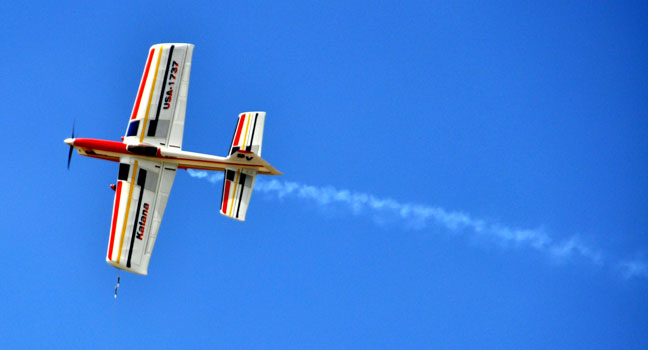
A stunter traces a trail in the blue sky at Muncie, Ind., during Precision Aerobatics qualifying in the 2009 National Model Airplane Championships. All photos contributed by Bruce Hunt.
For the last couple of years I've been privileged to serve as a judge at the NATS. There, over the course of four days, you get to watch over a hundred flights with some of the best pilots in the world competing for the Open Championship on the last couple days. In preparation for the competition, the twelve judges participate in a couple of training sessions and the joint judging of warm-up flights each day. The purpose of this training is to develop a consistent view of the relative quality of each maneuver flown. Some judges consistently scored critically while others scored leniently. The key goal here is to be consistent so that at the end of the day the top five pilots from your circle advance to the "Top Twenty" day competition. And, on the "Top Twenty" day, the top five pilots advance to the "Finals."
From this experience, I have developed what might be called a certain sensitivity to how a maneuver should be flown and an eye for the errors that most often occur. With this in mind I thought it would be helpful for pilots to hear what this judge looks for and sees as each maneuver is flown. What are the common errors? How does a judge determine a score? Up front I should say that this is my opinion and as "they" say, "Your mileage may vary."
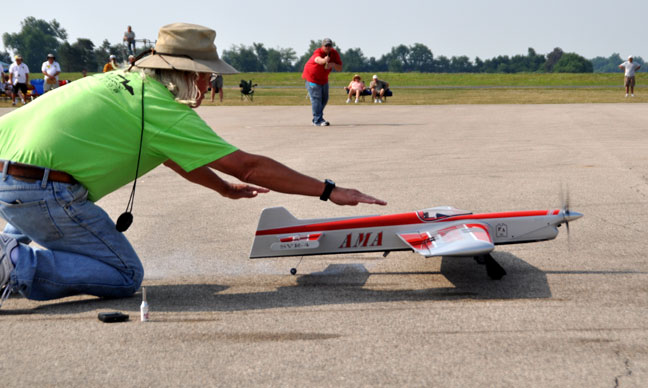
This maneuver starts with the release of the model and ends three laps later when the model passes over the point of release. In the first lap the model should gradually rise to normal level flight level. This seems easy, but I must say that I only saw this first lap flown correctly five times in 100 flights. In most cases pilots would reach normal flight level in less than a lap. Assuming the pilot takes off on the opposite side of the circle from the judges, a correctly flown first lap finds the model one foot off the ground at the first quarter lap and two feet as the model passes in front of the judges. That is at knee height after half a lap. When the model passes over the point of release it should be at the normal level flight height. Whatever the height is over the point of release, that height should not change for the next two laps. This is where the next most common error occurs. It is common for pilots to adjust the height after passing the point of release. A pilot might smoothly climb to the high side of the level flight range but then lower the flight height on subsequent laps. Or the reverse, after climbing to the low side of the level flight range, the pilot will raise the height on subsequent laps.
Two observations I've made when judging this maneuver have to do with the model's trim and the pilot's body position at release. First, the models that sit on their wheels most nearly level at release have an easier time making a gradual climb. And second, the pilots that crouch down at launch and only fully stand up after reaching normal flight level tend to have a more gradual climb.

There are two errors that almost always occur with the reverse wing over. First, the pull out to inverted flight is high. And second, the last wing over doesn't follow the same track as the first. Another common error occurs when the inverted pull out is too gradual instead of the abrupt pull out required. This is a difficult maneuver to fly well partly because it comes at the very beginning of the pattern. At this point the model is more nose heavy than it will be latter in the pattern because of the fuel load and, as a result, it is a bit more sluggish. To score well for this maneuver the transitions from level flight to vertical and vise versa need to be abrupt with the vertical maintaining a smooth straight path and the horizontal a consistent height. Changes in height or wiggles going overhead are sure ways to lose points.
The loop is, at the same time, both the easiest to fly and hardest to fly well of all the maneuvers. The most common error occurs at the very start of the maneuver when the model gradually enters the first loop putting the bottom behind of the start of the maneuver. The next most common errors are a size error that puts the top of the loop above 45 degrees and then a shape error that occurs on the back side of the loop as the model over turns on the way to a high bottom. Time and again pilots will fly this maneuver as if the only critical point is the placement of the bottom. While the bottom is important the points available for this maneuver are mostly determined from the consistency of three concentric round figures. When flown correctly the model turns uniformly through the whole maneuver with no flat spots. When pilots focus on the bottom, it is common to see an oval wider at the top and bottom with a definite flat spot on the bottom. A final common error occurs when the bottoms of the three loops move gradually left or right from the start of the loop. This "walking" of the maneuver usually results when the recovery from the top of the loop over turns putting the bottom high and the next loop offset from the first.
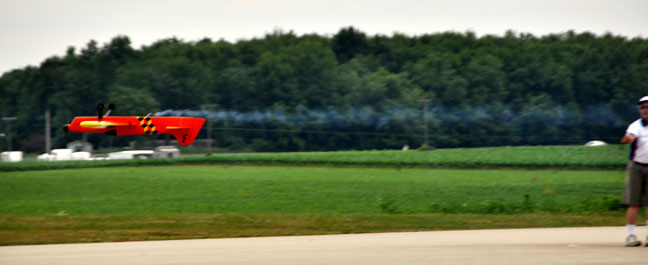
Most of the points lost during inverted flight come from two errors, flying the laps too high and adjusting the height during the two judged laps. A judge standing on the up-wind side of the circle should be able to see the top of the wing as it passes (that would be the underside now on top). More points are lost from varying flying height than from flying too high. As the model passes the judges, differences in flight height are easily noted.
These maneuvers can be difficult to judge consistently when they are not placed opposite the judges. Because of perspective, the side of the maneuver closest to the judges will appear higher making the top appear slanted. Other cues from the sound of the engine and the timing of the turns also become important when the shape and size cannot be judged directly. I look for four flat sides of the same size first and the consistency of size and placement second. When these two aspects of the maneuver are done well the maneuver disserves a good score. To get an excellent score, however, the maneuver must also have quality turns, abrupt without being jerky and smooth without being soft. This is where all that work trimming the model pays off. A couple notes on trim choices that affect the square maneuvers seem appropriate at this point. Models with higher RPM lower pitch props seem to present better because of less acceleration out of a corner and this combined with the speed regulation of a tuned pipe or a good 2-4 break makes the size of the sides not only look the same but occur at equal points in time. On the other side of this issue are over-powered models with fast lap times that rush the sides and corners of the maneuver. A consistent error occurs with the outside square loops when the entry is started from above 45 degrees. It is common for pilots to start the outside square loop high or climb just before the diving turn. In the extreme case some pilots will enter the maneuver from a slight wing over. Points are lost because the entry and exit points are not the same.

The triangle is setup by an accurate first turn of 120 degrees but loses most points in the second turn which pilots generally under turn with a turn of 90 degrees or less. This makes for a third turn of 150 degrees or, more often, a soft round recovery to the bottom of the maneuver. As a judge, it is easy to see the inside angle at the top of the triangle and the quality of the third turn. Very few pilots fly this maneuver well. Common errors include under or over turning the first turn and not reaching a peak at 45 degrees.
This maneuver starts and ends with the model touching vertical at the intersection between the inside and outside loop halves of the figure eight. A judge is looking for round loops of the right size, consistent intersections, and bottoms at normal flight height. The most common error happens at the transition between the inside and the outside loop when the pilot flies through the transition creating a vertical flat side on both loops. The maneuver takes on a shape of back to back D's. A second common error is a shape error that occurs when the model is overturned on the outside half of each loop creating tall narrow ovals. A third, and very common error happens on the second outside loop when control is relaxed after the bottom causing the model to overfly the intersection to the right putting the exit to the right of the entrance. Remember the maneuver is not over until the model goes vertical on the last outside loop.
The Horizontal Square Eight is mostly a maneuver where the judge looks for size and consistency. The sides, tops and bottoms of the adjacent square loops should be of the same size while the tops, bottoms and intersections should coincide . The most common error is having an inconsistent vertical intersection. For this maneuver the inconsistency can be of either height or placement. A common pilot error occurs when the tops of the inside or outside square loops are shortened compressing the maneuver and making the intersection overlap. The quality of the corners determines whether the maneuver receives a good score for smooth corners or an excellent score for abrupt corners.
Pilots tend to fly the first inside loop of the vertical eight larger than the required 45 degrees. A large inside loop compresses the outside loop at the top or more commonly causes the pilot to fly past the vertical. A common observation is that the maneuver resembles a "snowman." The most common error occurs at the transition between the inside and outside loops when the pilot flies a flat intersection on the way up and rises through the intersection on the way down. It is common for the second inside loop to be larger than the first with the intersection moving either left or right from the original intersection. This occurs when the right half of the bottom inside loop turns too quickly moving the bottom to the left of the original entry. While the last half inside loop to the bottom is not part of the scored maneuver, a smooth turn to the bottom that follows the line of the first loop helps accentuate the shape and placement of the vertical eight.
There are three common errors in the overhead eight. The first and most common is placing the maneuver with its intersection in front of the pilot instead of directly overhead. The second most common error is crossing the intersection between the inside and the outside loops as an "X" instead of meeting the entry line on the tangent. The third is flying the inside and outside loops too large with the outside edges below 45 degree.
The judges are looking for one major thing in the four leaf clover, the right angled crossing of a horizontal entry and vertical exit line that are tangent to the inside edges of the one inside loop and three 3/4 loops. Of course the bottom of the maneuver must be at normal flight height, but the common errors occur with the starts of the second, third and fourth leaves of the Clover. It is common for the first outside loop to be started too early resulting in a vertical climb through the first inside loop. Once this error is made the rest of the maneuver is impossible to correct. The next most common error is to put a slight climb into the inverted entry to the last inside loop.
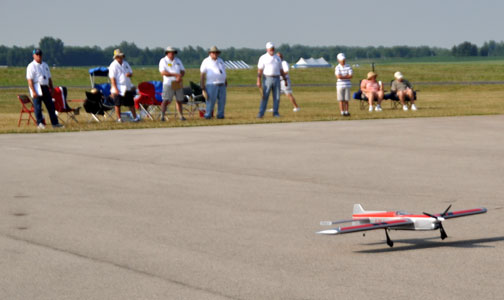
The landing is scored from the moment after the engine has stopped and the model is in level flight. From that moment the approach to touch down is observed for a gradual and uniform decent to "touchdown." Touchdown should occur with no noticeable bounce to receive maximum points. A common error occurs just after the engine stops when the model quickly loses speed and as a result rises or falls prior to its glide. As would be expected, the most common error occurs at touchdown when the model bounces prior to rolling to a stop.
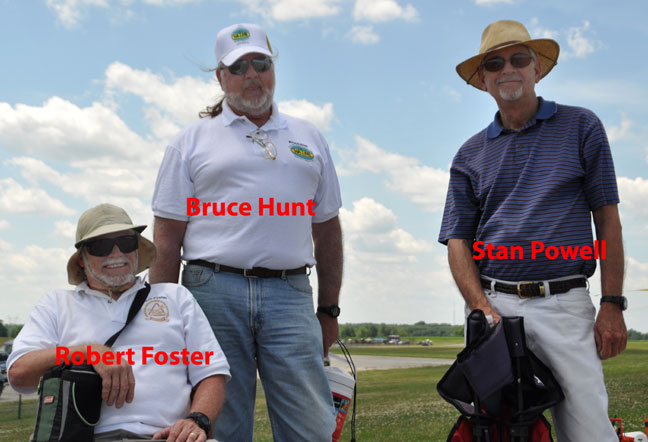
Author Bruce Hunt at the 2009 Nats with a couple of his fellow judges.
This page was updated March 24, 2010